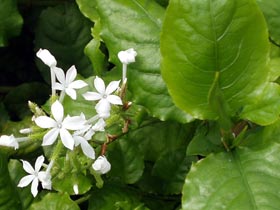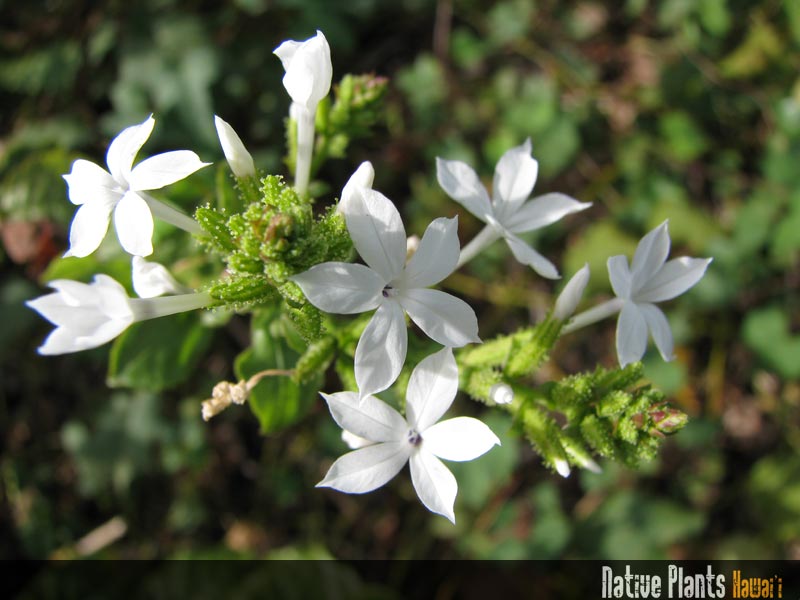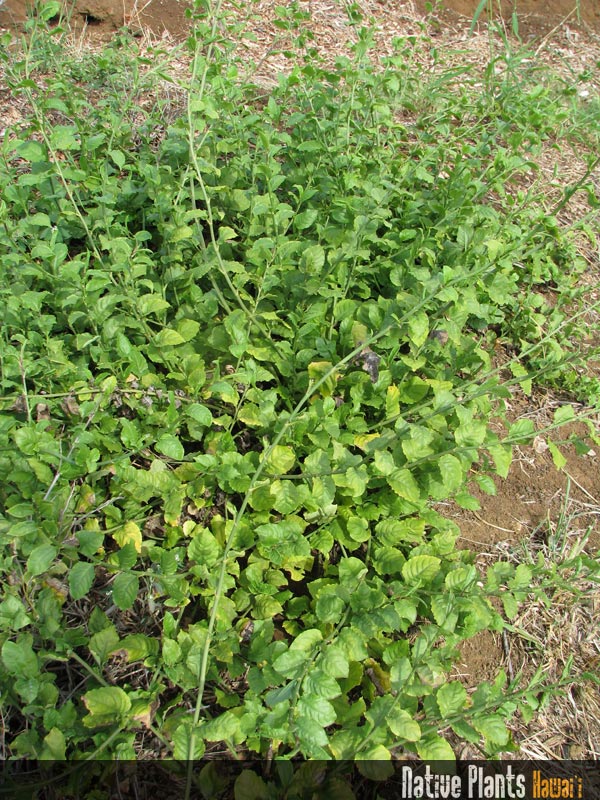Plumbago zeylanica
Genus
Plumbago
Species
zeylanica
Hawaiian Names with Diacritics
- ʻIlieo
- Hilieʻe
- Lauhihi
- ʻIlieʻe
- ʻIliheʻe
Hawaiian Names
- Hiliee
- Iliee
- Ilieo
- Ilihee
- Lauhihi
Common Names
- White leadwort
- Wild leadwort
Distribution Status
Indigenous
Endangered Species Status
No Status
Plant Form / Growth Habit
- Non-Woody, Spreading
Mature Size, Height (in feet)
- Herbaceous, Short, Less than 1
- Herbaceous, Medium, 1-3
Mature Size, Width
ʻIlieʻe has a spread of 15 feet or more.
Life Span
Long lived (Greater than 5 years)
Landscape Uses
- Accent
- Container
- Erosion Control
- Ground Cover
- Hedges
Additional Landscape Use Information
ʻIlieʻe is a strong ground cover and is ideal for stabilizing soil erosion. This is an excellent alternative for wedelia and non-native plumbagos.
Plant Produces Flowers
Yes
Flower Type
Not Showy
Flower Colors
- White
Additional Flower Color Information
ʻIlieʻe has white tubular flowers with green ribs and blue and purple anthers. Flowers grow on racemes.
Blooming Period
- Year Round
- Sporadic
Plant texture
- Fine
- Medium
Additional Plant Texture Information
Leaves range from 1 to 5 inches long.
Leaf Colors
- Medium Green
Additional Pest & Disease Information
Plants are subject to attacks by ants, mealy bugs, aphids, spider mites, false spider mites (flat), scale, slugs and Chinese rose beetles.
Fertilizer
An application of a balanced slow release fertilize with minor elements every six months. Foliar feeding has proved very beneficial but does encourage rapid growth if done too often. [David Eickhoff, Native Plants Hawaiʻi] For greater flower production use a 15-30-15 fertilizer.
Pruning Information
ʻIlieʻe tolerates heavy pruning. Trim to keep confined to planting area and to encourage branching. The plants can be formed and managed as a low hedge, or allowed to grow as a free form low shrub in larger areas. [David Eickhoff, Native Plants Hawaiʻi]
Water Requirements
- Dry
Additional Water Information
Water plants when soil is dry. Though they will tolerate xeric conditions, ʻilieʻe looks best with regular irrigation in well drained soil.
Soil must be well drained
Yes
Light Conditions
- Full sun
- Partial sun
Additional Lighting Information
ʻIlieʻe can tolerate both full sun and partial shade. Plants grown in shadier locations acquire luxuriant growth but tends to lessens flower production.
Spacing Information
Plants should be spaced about 1 to 3 feet apart.
Tolerances
- Drought
- Wind
- Heat
Soils
- Sand
- Cinder
- Organic
Limitations
Sticky fruits adhere to clothing, skins and pets and may be a minor nuisance near walkways or other high traffic locations.
Natural Range
- Niʻihau
- Kauaʻi
- Oʻahu
- Molokaʻi
- Lānaʻi
- Maui
- Kahoʻolawe
- Hawaiʻi
Natural Zones (Elevation in feet, Rainfall in inches)
- Less than 150, 0 to 50 (Dry)
- 150 to 1000, 0 to 50 (Dry)
- 1000 to 1999, 0 to 50 (Dry)
- 2000 to 2999, 0 to 50 (Dry)
Additional Habitat Information
ʻIlieʻe is indigenous and naturally can be found in arid, disturbed areas, sand dunes, and dry forest and shrubland from sea level to about 2,000 feet.
![]() Special Features and Information
Special Features and Information
General Information
ʻIlieʻe belong to the Plumbago or Leadwort family (Plumbaginaceae) consisting of ten or more species. Plumbago zeylanica is the only native species in the Hawaiian Islands.
Apparently the Cape plumbago (P. auriculata), popular in Hawaiian landscapes, is naturalized in Keokea, below the Hana Hwy., East Maui. This species is a native of South Africa.
Etymology
The generic name Plumbago is derived from the Latin plumbum, lead, and agere, to convey, possibly to due the gray color the roots imparts when handeled.
The specific epithet zeylanica is from the Latinized name for Sri Lanka (Ceylon). [3]
Hawaiian Names:
Hilieʻe means to "stain dark brown." [4]
Lauhihi is a Niʻihau name for this plant.
Early Hawaiian Use
Medicinal:
The roots of ʻilieʻe are toxic, though, less than the red or blue flowered introduced species. But it was still used by early Hawaiians in small amounts to relieve toothaches or as a tonic. [1,4]
A poultice made from pounded bark, leaves and roots were applied to swollen body parts. The leaves and stems were made into a paste and put on sores. [2]
The dark sap was also used as a type of "baby medicine." [4]
Tatoo:
The sap was used by early Hawaiians for tattoos with hues ranging from navy blue to black. [4]
Additional References
[1] "Native Planters in Old Hawaii--Their Life, Lore, & Environment" by E. S. Handy and Elizabeth Green Handy, page 239.
[2] "Hawaiian Herbs of Medicinal Value," by D.M. Kaaiakamanu & J.K. Akina, page 25.
[3] "The Names of Plants" by David Gledhill, page 411.
[4] "In Gardens of Hawaii" by Marie C. Neal, page 667.
PHOTOS FOR THIS SPECIES CAN BE SEEN AT THE LINK (Copy & Paste to your browser):
https://www.flickr.com/search/?user_id=50823119%40N08&sort=date-taken-desc&view_all=1&text=Plumbago%20zeylanica
Plant Gallery
Back to Plant List
Other Nursery Profiles for Plumbago zeylanica



